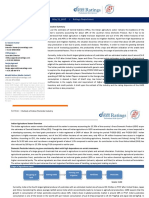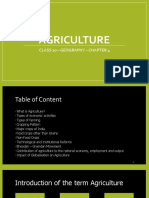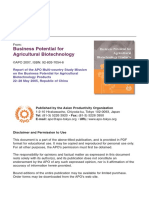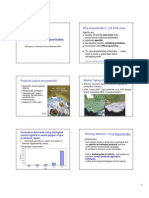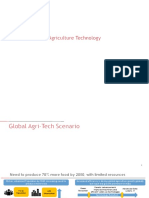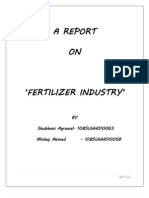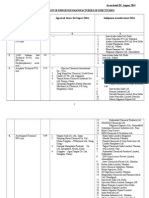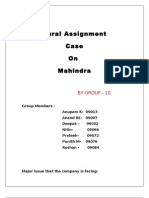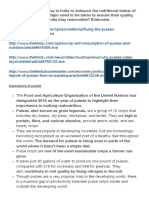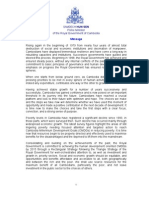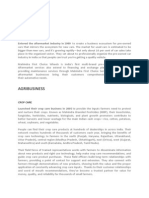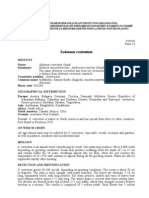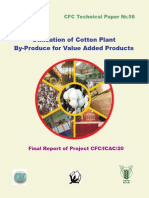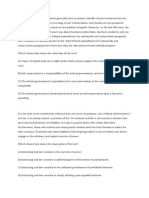Indian Fertilizer Industry
Indian Fertilizer Industry
Uploaded by
dreamzcastOriginal Description:
Copyright
Available Formats
Share this document
Did you find this document useful?
Is this content inappropriate?
Copyright:
Available Formats
Indian Fertilizer Industry
Indian Fertilizer Industry
Uploaded by
dreamzcastCopyright:
Available Formats
Size of Indian Fertilizer Industry
The production of food grains in India rose by an excess of 156 million MT since 1951-52. The fertilizer industry has played a major role in this mass production of food grains. The fertilizer industry came into being in India in the year of 1906. The first manufacturing unit of Single Super Phosphate (SSP) had a manufacturing capacity of 6000 MT.
As per Government of India records on 31.01.2007, the Indian fertilizer industry has made a production of 120.61 LMT of nitrogen (N) and 56.59 LMT of phosphatic (P) nutrient. The installed capacity of urea in India is estimated to be 207.52 LMT. These successes in the production by the fertilizer companies of India have crowned India the 3rd largest fertilizer producer in the world.
In 2005-06 the production of fertilizers in India was equally impressive. In nutrient terms (N, P and K), the annual consumption of fertilizers in 2005-2006 was 203.40 LMT. This was an increase by more than 200 LMT since 1951-52. Per hectare consumption of fertilizers has also witnessed a considerable growth. In 2005-06 per hectare consumption has scaled to 104.5 Kg while the figure was less than1 Kg in 1951-52.
The Indian fertilizer industry started operating in a big scale since 1940s, when the Fertilizer & Chemicals Travancore of India Ltd. and the Fertilizers Corporation of India were set up in Kerala and Bihar respectively. The fertilizer industry in India grew to a considerable extent in 1970s and 1980s after the emergence of the green revolution in the late sixties.
India has reached self-reliance in food-grain production. The country also generates surpluses to an extent that she can export. This massive production owes largely to the public sector as well as the cooperative sector of the fertilizer industry. Under the administrative control of the Department of Fertilizers, there are 9 public sector undertakings. The cooperative societies count two in number. The private sector has also contributed to the Indian fertilizer industry. Some of the notable private companies to contribute to the production are Chambal Fertilizers and Chemicals Limited and Tata Chemicals Limited. The private sector produced 44.73 % of nitrogenous fertilizers and 62.08 % of phosphatic fertilizers in 2006-07.
The Indian large size fertilizer units manufacture wide varieties of nitrogenous and phosphatic/
complex fertilizers. As in 2005-06, these large-scale fertilizer units count 56. In addition to the nitrogenous and phosphatic/ complex fertilizers, the large-scale units produce urea and ammonium sulphate as a by-product. The single super phosphate is produced in India by 9 units. Besides, there are 72 small and medium scale fertilizer units. These units operate mainly to produce SSP.
The production of urea in India has reached near self-sufficiency. The requirement of the nitrogenous fertilizers is met through the indigenous industry. In the case of phosphatic fertilizers, the raw materials and intermediates are imported in large scale. With the aid of the imported raw materials, phosphatic fertilizers are produced to meet the requirements for the domestic market. The requirement of potash (K) is met entirely through imports. No fertilizer unit of India has any reserve of potash.
The growth of the fertilizer industry was at its peak in the 1970s and 1980s. The growth was a bit stagnant in the last decade of the 20th century. But, with many radical steps been taken by the Government of India, the industry is expected to grow again.
The growth trajectory of the Indian fertilizer industry has camouflaged the impending challenges with which it is faced. Growth and development of agriculture in India derives a significant stimulus from the fertilizer industry.
Agricultural milieu in India could be jeopardized by the uncertainties in the fertilizer industry. The government is faced with the piquant situation, which demands a balance between the needs of the farmers and the fertilizer manufacturers.
The challenges before the Indian fertilizer industry relate to the incertitude in the supply of fertilizers. There has been a surge in the demand for fertilizers in the past few years. Good monsoonal showers have led to the growth in agriculture, inadvertently increasing the consumption rate of fertilizers. However, the robust growth in consumption propensity has not been met with the required surge in fertilizer production. This has widened the gap between the
demand and supply of fertilizers, which has led to an increase in the dependence of the country on imports. This also reflects on the lack of realizing of the domestic capacity utilization of the reserves in the country.
Another important factor that has led to the stunted growth of the fertilizer industry is the rise in prices of the feedstock. The fertilizer industry is dependent on gas for the production of urea and phosphoric acid for the production of phosphatic fertilizers and DAP. The country imports its inputs from other countries. The overseas suppliers of raw materials realize the predicament of the Indian fertilizer industry and have started exploiting the shortage through clever pricing.
In recent years, some of the private companies, dedicated to the production of fertilizers have affectively taken stakes in the overseas sources of raw materials. Although this has aided the industry, it has however been unable to reduce the government's burden of subsidizing the rates. The fertilizer industry is remained protected under the umbrella of the Retention pricing scheme of the Indian government.
The government has introduced policies to decontrol the prices but delayed the implementation of the parameters that have not augured in favor of the industry. As a result, fertilizer subsidies continue to mount and are expected to cross Rs. 50,000 crore in the year 2008. The pricing of the fertilizers are also dependent on the freight charges that are Baltic dry index.
The small size of the older plants and the low efficiency of the public sectors also pose as drawbacks of the industry. Recent policies of the government are directed towards revamping of these industries and restoring them to health.
The fertilizer industry is faced with other challenges inter alia infrastructural bottlenecks and the uncertainties in government policies. The delay in decision making and obscurity in setting parameters are among some of the major drawbacks of the government policies directed towards the industry.
To retrieve the health and growth of the fertilizer industry, the government of India is in need of long term realistic policies that would enable the industry to overcome the challenges and survive the present impasse.
Today, India stands as the third largest fertilizer consumer and producer of the world. It has been observed that the subsidies on Indian fertilizer have been rising at constant rate. This is due to the rise in the cost of production and the inability of the government to raise the maximum retail price of the fertilizers. The population of the country is rapidly increasing at 1.5% annually. This requires higher production of food grains. The total cropped area is only 30% of the net geographical area, which is not enough for increasing the agricultural productivity. Now, the main focus is on the improvement of the farm income, for which the fertilizer industry needs to lay more stress on the agricultural activities in the country. This will also help to improve terms between the government agencies and the fertilizer industry in India. CHAPTER 7. FERTILIZER DISTRIBUTION
Until 1989, the fertilizer industry and the fertilizer distribution system were elements of the centrally planned economy, with the sales monopolized by the 'Agrochem Company'. Most of the domestically produced and imported (potassium salts) fertilizers were distributed centrally among the provinces and channelled by Agrochem either directly to the state farms or to the marketing cooperatives, which had outlets in each commune (the smallest administrative unit covering a few to several villages). This system collapsed within a few months after introduction of the market-oriented system in 1989/1990. Most of the marketing cooperatives went bankrupt and the Agrochem Company was partly dissolved and partly privatized. The fertilizer market was in total confusion with few entrepreneurs seeking an easy profit and a crowd of farmers queuing for fertilizers at the factory gates. The prices rocketed to the rate 5 to 7 kg of wheat grain for 1 kg of nutrient and fertilizers were practically inaccessible for most farmers. Large fertilizer plants were fighting for survival. They began to export fertilizers and to rebuild the distribution channels in a market driven way. In 1991/92 the wholesale centres and dealer networks were implemented and each big producer established uniform factory prices for the whole country. The details of trading policies are not revealed but it is believed that most of the large factories (Table 9) are selling almost equal amounts of fertilizers through their own dealers network and through wholesale centres. In the case of one factory only, almost the total production is sold through its own dealer network. Today more than 3 000 retailers, connected with the main producers, are active on the fertilizer market, which intensifies the competition for the clients. For farmers, the prices of fertilizers are the same at the factory gate and at the local retailer level due to the discounts given by the producers to the distributors. The usual margin of profit offered to retailers is 5 to 10 percent of the fertilizer value. The payment system for delivered fertilizers is very flexible. In the case of the wholesaler the immediate remittance system is commonly used but in the case of dealers the payment is executed when the dealer acquires the dues from the farmer.
During the past four years the State has intervened slightly on the fertilizer market through preferential credit offered to farmers. The credit for purchasing the fixed amount of fertilizers at a low interest rate (half of the normal rate) is available for the period from planting to harvest. The amount of money secured for this kind of credit by the banks is, however, limited and only partly satisfies the farmers demand.
You might also like
- Feed Manufacturing ProcessDocument4 pagesFeed Manufacturing ProcessOMEGA SIAKACHA100% (3)
- Global Fertilizer IntelligenceDocument55 pagesGlobal Fertilizer Intelligencesunil_nagarNoch keine Bewertungen
- Rural Marketing: Assignment ofDocument8 pagesRural Marketing: Assignment ofNeha GoyalNoch keine Bewertungen
- 14 Neem Tobacco Oil Based Pesticide UnitDocument19 pages14 Neem Tobacco Oil Based Pesticide UnitAnonymous FWlt8YNoch keine Bewertungen
- Market Profile On Sulphuric AcidDocument4 pagesMarket Profile On Sulphuric AcidGovindanayagi PattabiramanNoch keine Bewertungen
- Fertiliser SectorDocument9 pagesFertiliser SectorShreemayee PandaNoch keine Bewertungen
- Fertilizer Marketing in India A Literatu PDFDocument7 pagesFertilizer Marketing in India A Literatu PDFAkshat SharmaNoch keine Bewertungen
- Fertilizer Policy in IndiaDocument242 pagesFertilizer Policy in IndiaArun D PaulNoch keine Bewertungen
- Outlook of Indian Pesticide IndustryDocument10 pagesOutlook of Indian Pesticide Industrysourabh_funNoch keine Bewertungen
- 1.1 INTRODUCTON of IFFCO:The Fertilizer Industry inDocument17 pages1.1 INTRODUCTON of IFFCO:The Fertilizer Industry insunil995100% (9)
- Bio PesticideDocument13 pagesBio PesticideKaren CandidoNoch keine Bewertungen
- Strategic Analysis of Indian Fertilizer IndustryDocument23 pagesStrategic Analysis of Indian Fertilizer IndustryParitosh Anand0% (1)
- Agriculture: Class 10 - Geography - Chapter 4Document69 pagesAgriculture: Class 10 - Geography - Chapter 4Shilpa Reddy50% (2)
- Fertilizer Industry in IndiaDocument24 pagesFertilizer Industry in Indiaapi-27369618100% (3)
- BIO BusinessPotentialDocument198 pagesBIO BusinessPotentialtwisham_08Noch keine Bewertungen
- Excel Crop CareDocument9 pagesExcel Crop CareMehul BhatiaNoch keine Bewertungen
- Chemical Vs Bio PesticidesDocument34 pagesChemical Vs Bio PesticidesDesh Deepak Sharma60% (5)
- Tata SwachDocument14 pagesTata SwachAshok Kumar PandeyNoch keine Bewertungen
- Introduction Bio PesticidesDocument5 pagesIntroduction Bio PesticidesPinkey RajpalNoch keine Bewertungen
- Agrochemical FicciDocument44 pagesAgrochemical Ficcigee emmNoch keine Bewertungen
- Avendus Agriculture TechDocument22 pagesAvendus Agriculture TechRicha SharmaNoch keine Bewertungen
- Agricultural Biotechnology in India, 2004Document21 pagesAgricultural Biotechnology in India, 2004ganeshraj007Noch keine Bewertungen
- Itc SwotDocument23 pagesItc SwotRaunak ChaudhuryNoch keine Bewertungen
- Tea Industry in IndiaDocument3 pagesTea Industry in IndiaVijay K RajanNoch keine Bewertungen
- Final Report On FertilizerDocument54 pagesFinal Report On FertilizerShubham Agarwal100% (8)
- Dant KantiDocument22 pagesDant KantiDeepen100% (1)
- Marketing Management Dant KantiDocument4 pagesMarketing Management Dant KantiKaran FrancisNoch keine Bewertungen
- Fertilizer Production in IndiaDocument5 pagesFertilizer Production in IndiaRajiv KhatriNoch keine Bewertungen
- International Dairy Brands in IndiaDocument29 pagesInternational Dairy Brands in IndiaRupam Aryan BorahNoch keine Bewertungen
- A Study On Market Potential, Farmers' Buying Behaviour, and Satisfaction Level Towards Water Soluble Fertilizers in Anand and Narmada Districts of GujaratDocument10 pagesA Study On Market Potential, Farmers' Buying Behaviour, and Satisfaction Level Towards Water Soluble Fertilizers in Anand and Narmada Districts of GujaratImpact JournalsNoch keine Bewertungen
- Insecticides: S.No Technical Name Formulation Trade NamesDocument13 pagesInsecticides: S.No Technical Name Formulation Trade NamesRamkannan Parasumanna Chandrasekaran75% (16)
- Sample - India Fertilizers Market (2018 - 2023) - Mordor IntelligenceDocument32 pagesSample - India Fertilizers Market (2018 - 2023) - Mordor IntelligenceAkshat SharmaNoch keine Bewertungen
- Tata NanoDocument6 pagesTata NanoAbira Bilal HanifNoch keine Bewertungen
- Bio PesticidesDocument45 pagesBio Pesticidesvishal BhanuNoch keine Bewertungen
- Pharmaceutical Industry in IndiaDocument0 pagesPharmaceutical Industry in IndiaBhuvan MalikNoch keine Bewertungen
- The Difference Between Information & Knowledge: Confidential-For Kagashin Clients Only May, 2014Document89 pagesThe Difference Between Information & Knowledge: Confidential-For Kagashin Clients Only May, 2014VIHARI DNoch keine Bewertungen
- Role of Agriculture Processing in Export Growth of Agricultural ProductsDocument8 pagesRole of Agriculture Processing in Export Growth of Agricultural ProductsAwadhesh YadavNoch keine Bewertungen
- Is India Ready For EV MakeoverDocument9 pagesIs India Ready For EV Makeoverfeedback.jinal467Noch keine Bewertungen
- EPU of Bio-Pesticides PDFDocument170 pagesEPU of Bio-Pesticides PDFBharatiyulamNoch keine Bewertungen
- PPR 5Document6 pagesPPR 5tejasNoch keine Bewertungen
- Mahindra CaseDocument4 pagesMahindra CaseNitin SinghNoch keine Bewertungen
- India The InnovatorDocument8 pagesIndia The InnovatorInnovationIndiaNoch keine Bewertungen
- Production and Export of TeaDocument4 pagesProduction and Export of TeaJose Tenny100% (1)
- Land Reforms & Agriculture - 1st - ChapterDocument18 pagesLand Reforms & Agriculture - 1st - Chaptersignjpcoe100% (1)
- Project On Indian Rural MArketDocument49 pagesProject On Indian Rural MArketSabby BnwNoch keine Bewertungen
- BE Mar 2020 Assignment SolutionDocument10 pagesBE Mar 2020 Assignment SolutionJATINNoch keine Bewertungen
- Book Reviews On The Fortune at The Bottom of The PyramidDocument12 pagesBook Reviews On The Fortune at The Bottom of The Pyramidhikaru otsuka100% (1)
- Sustainability Business Strategy Nestle.Document12 pagesSustainability Business Strategy Nestle.gurpreetNoch keine Bewertungen
- Essay On Atmanirbhar BharatDocument2 pagesEssay On Atmanirbhar BharatTanmay Pramanik100% (1)
- Unilinear and Non Unilinear ParadigmDocument4 pagesUnilinear and Non Unilinear ParadigmVansh Rajput50% (2)
- Agri Input ScenarioDocument10 pagesAgri Input ScenarioVikas_Chaturvedi_318100% (1)
- National Resource Efficiency Policy (NREP) 2019) Draft PDFDocument59 pagesNational Resource Efficiency Policy (NREP) 2019) Draft PDFKumar Ravi100% (1)
- Importance of PulsesDocument3 pagesImportance of Pulsesseesi alterNoch keine Bewertungen
- Product Mix DaburDocument29 pagesProduct Mix DaburgetgauravsbestNoch keine Bewertungen
- Oligopoly and OPEC As An OligopolyDocument6 pagesOligopoly and OPEC As An OligopolyBhaumit Zaveri50% (4)
- 07 - Strategy-Business - The Fortune at The Bottom of The Pyramid - Prahalad and Hart PDFDocument16 pages07 - Strategy-Business - The Fortune at The Bottom of The Pyramid - Prahalad and Hart PDFRESMITA DASNoch keine Bewertungen
- Food Processing Sector in IndiaDocument18 pagesFood Processing Sector in IndiaSuresh Kumar VengaliNoch keine Bewertungen
- Case Study UflexDocument13 pagesCase Study UflexabhiamityNoch keine Bewertungen
- Background Paper Agri StartupsDocument19 pagesBackground Paper Agri Startupsnakul_069Noch keine Bewertungen
- Profile of The Fertilizer and Chemical IndustryDocument15 pagesProfile of The Fertilizer and Chemical Industrydevika20Noch keine Bewertungen
- SonalikaDocument37 pagesSonalikaHarmeet singhNoch keine Bewertungen
- Evaluation and Preparation of Guava Jam Stored at Ambient TemperatureDocument10 pagesEvaluation and Preparation of Guava Jam Stored at Ambient Temperatureiftikhar AhmedNoch keine Bewertungen
- (Download PDF) Biochar Application Essential Soil Microbial Ecology 1St Edition T Komang Ralebitso Senior Online Ebook All Chapter PDFDocument42 pages(Download PDF) Biochar Application Essential Soil Microbial Ecology 1St Edition T Komang Ralebitso Senior Online Ebook All Chapter PDFjavier.vick279100% (18)
- Agriculture Reporting: 3rd Place - Hope Mafaranga, New VisionDocument1 pageAgriculture Reporting: 3rd Place - Hope Mafaranga, New VisionAfrican Centre for Media ExcellenceNoch keine Bewertungen
- Legend of Mariang SinukuanDocument2 pagesLegend of Mariang Sinukuanmoshavila32509100% (1)
- Cambodia NSDPDocument120 pagesCambodia NSDPCambodia_SRINoch keine Bewertungen
- The Daily Union. January 9, 2014Document16 pagesThe Daily Union. January 9, 2014DUNewsNoch keine Bewertungen
- Wheat Production HandbookDocument46 pagesWheat Production HandbookAnonymous im9mMa5Noch keine Bewertungen
- Mahindra ServicesDocument23 pagesMahindra Servicesprasenjit_baishyaNoch keine Bewertungen
- Aboriginal Fire ManagementDocument7 pagesAboriginal Fire ManagementskyeandoNoch keine Bewertungen
- It Is Time To End Food WasteDocument16 pagesIt Is Time To End Food WasteJorge Luis Alonso G.100% (1)
- Gillon (2016) Flexible For Whom Flex Crops Crises Fixes and The Politics of Exchanging Use Values in US Corn ProductionDocument24 pagesGillon (2016) Flexible For Whom Flex Crops Crises Fixes and The Politics of Exchanging Use Values in US Corn ProductionGustavo LagaresNoch keine Bewertungen
- 30 - ITB - Case Study - EVS - Akarsh SinghDocument17 pages30 - ITB - Case Study - EVS - Akarsh SinghAkarsh SinghNoch keine Bewertungen
- Category NZ Halal 2Document7 pagesCategory NZ Halal 2sayajaswadiNoch keine Bewertungen
- 4.1 A Future View of Precision FarmingDocument15 pages4.1 A Future View of Precision FarmingQiu AnNoch keine Bewertungen
- Liberia's Forestry ReportDocument92 pagesLiberia's Forestry ReportLiberiaEITINoch keine Bewertungen
- NRAES 33 - Greenhouse Engineering TextbookDocument287 pagesNRAES 33 - Greenhouse Engineering Textbooktimothy.yueNoch keine Bewertungen
- Biofuel EnergyDocument8 pagesBiofuel Energylokesh0144Noch keine Bewertungen
- Goat Fattening Rs. 0.85 MillionDocument18 pagesGoat Fattening Rs. 0.85 MillionZakir Ali100% (1)
- Foote, 2002. The History of Artificial InseminationDocument11 pagesFoote, 2002. The History of Artificial Inseminationrodrigoferrazza1662Noch keine Bewertungen
- The Jet Volume 10 Number 4Document28 pagesThe Jet Volume 10 Number 4THE JETNoch keine Bewertungen
- How To Start Catfish Farming at Home-Backyard Fish FarmingDocument2 pagesHow To Start Catfish Farming at Home-Backyard Fish FarmingFolajimi AleshinloyeNoch keine Bewertungen
- Rottweiler - Wikipedia, The..Document4 pagesRottweiler - Wikipedia, The..xskaos5228Noch keine Bewertungen
- 2.1 Malaysian Water SupplyDocument28 pages2.1 Malaysian Water SupplyAnusha PrakashNoch keine Bewertungen
- 02-9196 DS SolrsDocument4 pages02-9196 DS SolrsŁukasz JóźwickiNoch keine Bewertungen
- Cotton ICAR ReportDocument87 pagesCotton ICAR ReportanamikashikhaNoch keine Bewertungen
- Bài Tập Main Idea - Main PurposeDocument15 pagesBài Tập Main Idea - Main PurposeThuần PhạmNoch keine Bewertungen
- Capitalism and Ecological Crisis by Yonghong ZhangDocument5 pagesCapitalism and Ecological Crisis by Yonghong Zhangcefpryahoo.comNoch keine Bewertungen
- WWF Discussion Paper June 2014 BECCSDocument14 pagesWWF Discussion Paper June 2014 BECCSWWFColombiaNoch keine Bewertungen








